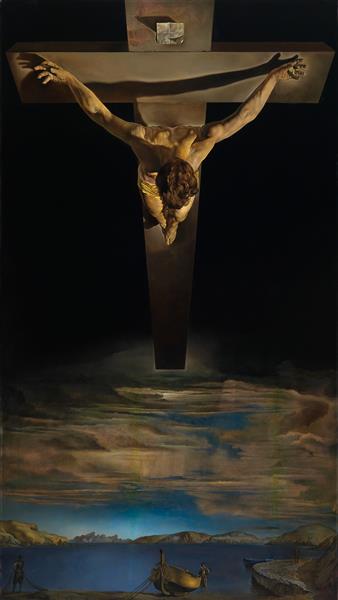In the summer of 1951, Salvador Dalí, the enigmatic and eccentric genius of surrealism, unveiled one of his most striking and controversial masterpieces: "Christ of Saint John of the Cross." This painting, which portrays Christ on the cross in a dramatically unique perspective, has a story as fascinating as the man who created it.
 Christ of St. John of the Cross. WikiArt
Christ of St. John of the Cross. WikiArt
The genesis of the painting can be traced back to a mystical experience Dalí had. He claimed to have been inspired by a cosmic dream, in which he saw Christ as the center of the universe. The dream was vivid and powerful, filled with divine light and geometric harmony. This vision was the catalyst for Dalí's determination to create a representation of Christ that would transcend traditional religious iconography and capture the divine essence he had witnessed.
However, the painting's conception wasn't purely divine. Dalí found further inspiration from a small sketch made by the 16th-century Spanish friar and mystic, Saint John of the Cross. The sketch, drawn on a scrap of paper, depicted Christ on the cross from an unusual, elevated perspective. Saint John of the Cross's vision resonated deeply with Dalí, who saw in it the perfect embodiment of his own mystical experience.
To bring his vision to life, Dalí sought to perfect the anatomy and realism of Christ's figure. He meticulously studied the anatomy of Christ by using a model, a Hollywood stuntman, who was suspended on a cross-like structure to ensure the accuracy of the musculature and posture. Dalí's dedication to precision was so intense that he even consulted with doctors to ensure the anatomical correctness of the depiction.
The final painting is a striking composition. It shows Christ suspended on a dark cross, floating above a tranquil sea illuminated by the setting sun. The perspective is dramatic, looking down on Christ from above, with his body forming a geometric perfection against the vast sky and water. This unusual angle gives the viewer a sense of both divinity and humanity, as if witnessing the crucifixion from a heavenly vantage point.
Upon its unveiling, "Christ of Saint John of the Cross" sparked immediate controversy and debate. Traditionalists and religious leaders were taken aback by the unconventional depiction, arguing that it strayed too far from traditional representations of Christ. Dalí, known for his provocative and avant-garde style, was unperturbed by the criticism. He believed that art should challenge and inspire, and he saw his painting as a means to convey the mystical and universal nature of Christ's sacrifice.
Despite the initial controversy, the painting's profound impact and unique perspective gradually won over many critics and art enthusiasts. Today, "Christ of Saint John of the Cross" is celebrated as one of Dalí's most iconic works, housed in the Kelvingrove Art Gallery and Museum in Glasgow, Scotland. It stands as a testament to Dalí's genius and his ability to blend the mystical with the scientific, the divine with the human.
The story of "Christ of Saint John of the Cross" is a reflection of Dalí's complex personality and his relentless pursuit of capturing the sublime. It is a story of a visionary artist who dared to see the world differently and, in doing so, created a masterpiece that continues to inspire and provoke thought over seven decades later.
 Christ of St. John of the Cross. WikiArt
Christ of St. John of the Cross. WikiArt